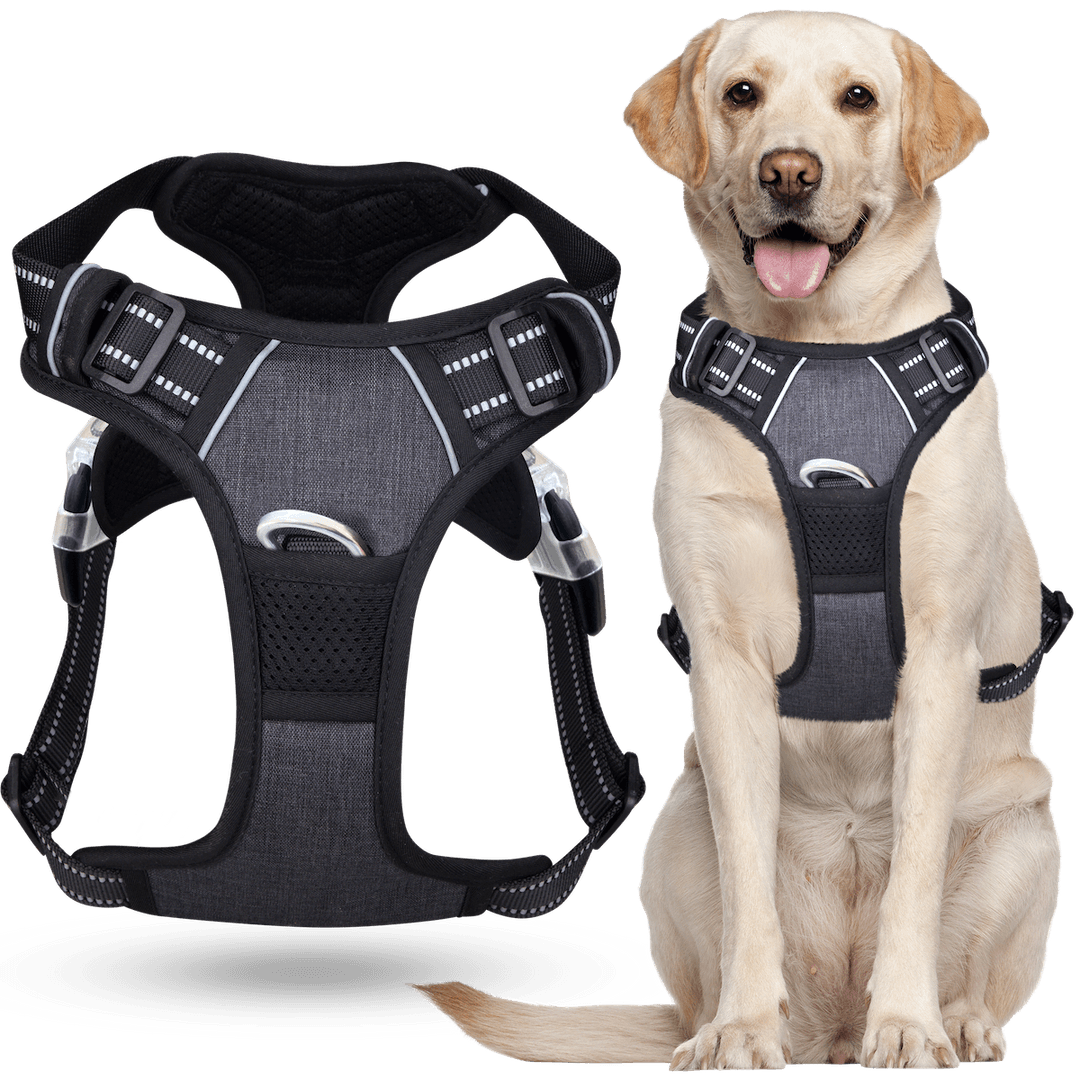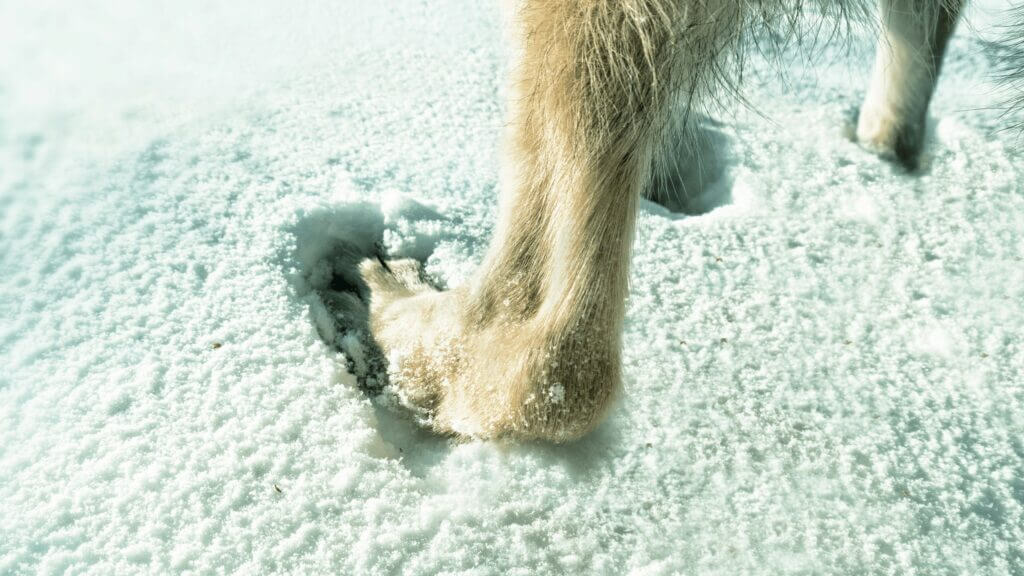
If you’re wondering, “Why are my dog’s back legs shaking,” then it’s time to do some research. Tremors and shakes in the legs are usually a sign of trouble, and it may mean a visit to the vet.
Of course, joint pain and arthritis are common problems in dogs and one of the main reasons you may see the hind legs shivering. So keeping your dog on mobility dog chews is essential for their quality of life. However, when you notice weak hind legs, shaking legs, and leg tremors in dogs, there are many possible causes.
To really get into the issue of why a dog’s legs shake, whether it’s the front legs or hind legs, we consulted the work of leading experts like Dr. Janet Steiss, DVM[1], on muscle disorders, Dr. Platt, DVM, on neurological issues, Dr. Everts, DVM[2] on bone disorders and Dr. Abrar Haq[3] for expert insights on canine psychology. So read on for everything you need to know if you notice, tremors, twitching, shaking, or shivering in your dog’s limbs.
Table of Contents
So, Why Is My Dog’s Back Leg Shaking?
Dogs usually shake their back legs as a natural reflex when you scratch them. However, dog hind limbs can also shake out of fear, pain, muscle atrophy, exhaustion, hypoglycemia, poisoning, infection, or a neurological issue. Other possible causes involve injuries, nerve damage, infections, and degenerative diseases. The cause is not usually cold, as cold would make the whole body shake.
Tremors in dogs are involuntary muscle movements that look like shaking, shivering, or trembling, much like when dogs shake their bodies when excited. In some rare cases, it can be because a dog’s leg falls asleep after sleeping too long in one position. Of course, a dog’s hind leg may shake as an involuntary response to when you are scratching a sweet spot. This is a natural reflex.
They can look a lot like seizures, as both involve abnormal muscle contractions, but unlike seizures, tremors won’t make a dog lose consciousness, and they don’t happen because of the abnormal firing of neurons in the brain, as in a seizure. Of course, tremors usually happen to the whole body, like when a dog is cold, so something may be wrong when you see shaking primarily in the back legs.
And, of course, we assume here you don’t mean when you’re dog shakes their back leg because they’re getting scratches and belly rubs. That is simply a reflex.
14 Reasons For Dog Legs Shaking
So let’s get into the most common reasons for shaking in the back legs and what leg shaking in dogs means.

1. Strong Emotions
A common reason dogs shake in their legs is extreme fear. Now, shivering and trembling from fear is usually the whole body, but when dogs are standing and afraid, they may dip their hind end when they tuck their tail, putting their hind legs in a squat position. Keeping low to the ground this way can cause their legs to grow tired and start to shake. This means you may see the shaking in the legs more than in the rest of the body.
However, any strong emotion, like anxiety, stress, joy, or excitement, can cause tremors that you may notice mainly in the back legs. Many anxious dogs, like some Chihuahuas, are known for their shaking, and it can sometimes be a sign of extreme submissive behavior, like nervous peeing, or the whale eye.

2. Poisoning
Certain toxins and poisons have neurological effects that cause tremors and convulsions that you may first see as tremors in the dog’s back legs. This can be from an overdose of some tick and flea medications (so never give your dog too much) or other toxins, including mold from stale food in the trash or poisons. The video below shows back leg tremors in a poisoned German Shepherd:
If you suspect your dog is poisoned, see a vet immediately, as this can be life-threatening, and time is of the essence.
3. Muscle Weakness and Fatigue
One of the leading causes of shaking back legs in dogs is muscle weakness or fatigue. Just like humans, dogs can experience muscle fatigue after prolonged physical exertion or excessive exercise. This can manifest as trembling or shaking in the back legs as the muscles struggle to support the dog’s weight. For dogs needing extra support during walks, check our proper harness sizing guide.
Overexertion during play, running, or strenuous activities can strain the muscles and result in temporary shaking. Adequate rest and recovery are essential, allowing the muscles to regain strength.

4. Muscle Atrophy
Senior dogs often start to lose weight when their muscles atrophy, particularly around their spine and hips, if they have hip dysplasia, stenosis, or other sources of chronic pain.
Muscle atrophy[4] refers to the loss of muscle mass and strength, weakening the affected muscles. With weak muscles, the legs may shake when the dog stands. It can occur due to various reasons, including:
- Lack of physical activity;
- Prolonged inactivity or immobilization;
- Nerve damage or dysfunction; and
- Certain medical conditions.
When the muscles in the back legs are not actively engaged or stimulated, they can begin to waste away, resulting in weakness and trembling. In most cases, low-impact exercises like hydrotherapy, physiotherapy, and high-protein diets can combat muscle atrophy.
5. Hypoglycemia
Hypoglycemia, or low blood sugar, can induce shaking in a dog’s back legs. This condition is common in small breeds, such as Chihuahuas, Teacup Maltese, and Yorkshire Terriers, but can affect any dog.
Hypoglycemia can occur for various reasons, including prolonged fasting, inadequate nutrition, or insulin-related disorders in diabetic dogs. The shaking typically subsides once the blood sugar levels stabilize. If you suspect hypoglycemia, see your veterinarian for a thorough examination and appropriate treatment.
In the video below, you can see a diabetic dog struggling with low blood sugar and shaking in the legs:

Stop Your Dog Pulling On Their Leash
Front and back clip points help redirect pulling so you get immediate, gentler control and can actually enjoy the walk again.
Shop Now 👉Better Walk Guarantee • 90-Day PawSafe® Promise
6. Chronic Pain or Discomfort
Pain or discomfort in a dog’s back or hind legs can trigger shaking or trembling. Conditions like arthritis can cause pain and weakness, causing shaking. Observing your dog’s movements is crucial, and checking for signs of discomfort, such as limping or difficulty getting up or lying down.
7. Nerve Disorders
Nerve disorders can also be responsible for dogs experiencing shaking in their back legs. Conditions such as:
- Degenerative myelopathy;
- Spinal strokes or Fibrocartilaginous Embolism (FCE);
- Vestibular syndrome[5] (which can also cause dogs to walk in circles); or
- Other spinal cord injuries can lead to weakness and trembling in the hind legs. For dogs experiencing severe weakness, back legs giving out is a serious concern.
Intervertebral disc disease (IVDD), which involves compression or damage to the spinal discs, can also cause similar symptoms. Other neurological disorders, including nerve impingement or trauma, can contribute to shaking hind legs.
Timely veterinary evaluation, including neurological examinations and possibly imaging tests, can help identify the underlying cause and guide appropriate treatment or management options.
8. Injuries or Trauma
Trauma or injuries can lead to a dog’s back leg shaking. These injuries can affect the muscles, bones, joints, nerves, or ligaments, resulting in pain, weakness, and involuntary trembling. Here are some common examples:
- Fractures or broken bones in the back leg can cause severe pain and instability. The dog may experience shaking due to the injury and the body’s attempt to protect the injured area.
- Sprains occur when ligaments supporting the joints are stretched or torn, while strains involve damage to muscles or tendons. These injuries can cause pain and muscle weakness, leading to shaking in the affected leg.
- Joint dislocations occur when the bones in a joint become displaced. This can cause intense pain and instability, leading to shaking or trembling in the back leg.
- Trauma to the soft tissues, such as contusions, lacerations, or deep cuts, can result in pain, inflammation, and subsequent muscle spasms or shaking.
- Injuries that involve damage to nerves in the back leg can cause shaking or trembling. Nerve compression (pinched nerves), entrapment, or trauma can disrupt the normal signaling between the brain and the leg muscles, leading to involuntary movements.
- Dogs undergoing orthopedic surgeries, such as joint repairs or ligament reconstructions, may experience shaking in the affected leg during the recovery phase. This can be a normal response to surgery-induced pain and postoperative healing.
9. Parasites
Certain kinds of parasites carry diseases that can attack the nervous system. This can cause various symptoms, including paralysis and weakness, and sometimes affects the back legs. Some of these parasites include tapeworms, roundworms, and flukes.

10. Metabolic Disorders
Disorders like Diabetes can cause low blood sugar levels and can result in tremors and shaking in dogs. This can also occur due to conditions like insulinoma (a tumor in the pancreas) or inadequate glucose production.
Similarly, Liver disease or dysfunction can lead to the accumulation of toxins in the bloodstream, causing neurological symptoms such as tremors.
11. Autoimmune Disorders
Some autoimmune diseases like Myasthenia Gravis affect the neuromuscular junctions, leading to muscle weakness and tremors, including in the back legs.
Another possibility is Systemic Lupus Erythematosus (SLE), which can cause inflammation in various organs, including the muscles, leading to tremors and weakness.
12. Infectious Disorders
Some infections cause tremors which may be most noticeable in a dog’s back legs. Canine Distemper is a highly contagious viral infection that can affect the nervous system, leading to neurological symptoms such as tremors and muscle spasms.
Many Tick-borne infections, such as Lyme disease or Rocky Mountain spotted fever, can cause muscle weakness, tremors, and other neurological signs.

Make Every Walk Feel Under Control
Adjustable comfort design helps reduce leash tension fast so walks become calm, consistent, and more enjoyable for both of you.
Shop Now 👉Better Walk Guarantee • 90-Day PawSafe® Promise
13. Dog Hind Leg Shaking as a Reflex to Scratching or Petting
Sometimes, when you scratch or pet a dog in just the right spot (often on their belly or near the base of their tail), they might start shaking or thumping their back leg. This is known as a scratch reflex and is typically a normal and harmless reaction. The movement is involuntary and similar to the way our leg might jerk when the doctor taps our knee with a hammer. It’s often interpreted as the dog being ticklish or enjoying the petting.
14. Paw Injuries Causing Leg Shaking
On the other hand, if a dog is shaking their leg while standing, especially if they avoid putting weight on it, this may signal a paw injury or discomfort. Dogs can experience various paw issues like cuts, abrasions, stings, or foreign objects lodged in their foot pads. Any of these instances might cause them to shake their leg in an attempt to alleviate pain or remove the irritant. It is vital to inspect their paw to ensure there’s no injury and consult a vet if needed, to manage pain and prevent infection. Always approach with caution and gentleness, as a dog in pain might react defensively.
Differences in Dog’s Leg Shaking: Lying Down vs. Standing
Shaking dog legs can be observed in various contexts and may signal different things based on whether they are lying down or standing.
1. Dog’s Back Leg Shaking While Lying Down
- Relaxation: Sometimes, a dog’s leg might twitch or shake slightly when they are deeply relaxed or in a certain stage of sleep (REM, where dreaming occurs).
- Dreaming: Dogs, like humans, do dream. Twitching of the legs during sleep might merely indicate an active dream state.
- Old Age or Pain: In some older dogs, shaking while resting might relate to pain or discomfort, especially in the hip area, which may indicate arthritis or hip dysplasia.
2. Dog’s Back Leg Shaking While Standing
- Muscle Weakness and Sprains: If a dog’s leg shakes while standing, it might be a sign of muscle weakness or muscle loss, especially in older dogs or dogs recovering from an injury. It can also mean your dog has sprained a muscle or hurt a ligament.
- Joint Issues: Joint problems, like arthritis or hip dysplasia, might also cause shaking during standing due to pain or instability in the legs.
- Nervousness or Anxiety: Sometimes, stress, anxiety, or nervousness may also manifest physically through shaking or trembling while standing.
- Excitement or Anticipation: Dogs might also tremble out of excitement or anticipation for something they enjoy, like the prospect of a walk or mealtime.
In both scenarios, continuous or excessive leg shaking that doesn’t appear to be related to dreams or excitement should warrant a veterinary check to rule out potential health issues. Any form of consistent shaking, limping, or indication of pain is a valid reason to seek professional advice to ensure your pup is in the best possible health and not suffering silently. Always observe your pet closely for any behavior changes or signs of discomfort to address possible issues promptly
What Should I Do When I Notice My Dog’s Back Leg Is Shaking?
1. Stay Calm
It’s natural to feel concerned when you notice unusual behavior in your dog. However, it’s important to remain calm and composed. Dogs can pick up on their owners’ emotions, and staying calm will help reassure your pet.

Enjoy Calm Walks Starting Today
Dual-attachment harness distributes pressure and helps turn tug-of-war outings into relaxed, bonding strolls from the first use.
Shop Now 👉Better Walk Guarantee • 90-Day PawSafe® Promise
2. Observe the Behavior
Take note of when the shaking occurs, how long it lasts, and any accompanying symptoms or changes in behavior. This information will be helpful when discussing the issue with your veterinarian.
3. Check for Signs of Pain or Discomfort
Gently examine your dog’s leg and surrounding areas for any signs of pain, swelling, or injury. Look for limping, difficulty in bearing weight, or sensitivity to touch. Be cautious and avoid causing further discomfort to your dog during the examination.
4. Ensure a Safe Environment
Create a safe and quiet space for your dog to rest. Remove any potential hazards or objects that may cause additional stress or injuries. Providing a calm environment can help alleviate anxiety and promote relaxation.
5. Contact Your Veterinarian
It is recommended to reach out to your veterinarian as soon as possible. Describe the shaking behavior, provide any relevant details, and schedule an appointment for a thorough examination. The veterinarian will be able to assess your dog’s overall health and determine the underlying cause of the shaking.
6. Follow Veterinary Guidance
Based on the examination, your veterinarian may recommend additional diagnostic tests, such as blood work, X-rays, or ultrasounds, to further investigate the cause of the shaking. Follow your veterinarian’s advice regarding any necessary treatments or management strategies.
7. Provide Comfort and Support
During this time, offer your dog comfort and reassurance. Ensure they have access to fresh water, a comfortable resting area, and a balanced diet. Follow any prescribed medications or treatments diligently.
Remember, shaking in a dog’s back leg can have various causes, ranging from temporary muscle fatigue to underlying medical conditions. Prompt veterinary attention is essential for an accurate diagnosis and appropriate treatment. Your veterinarian will guide you through the necessary steps to address the issue and help your dog recover their well-being.
Final Thoughts
While witnessing a dog’s back legs shaking can be disconcerting, understanding the most common reasons behind this behavior can assist in identifying the underlying cause and seeking appropriate care. From muscle weakness and fatigue to hypoglycemia, pain or discomfort, nerve disorders such as degenerative myelopathy or intervertebral disc disease, vestibular syndrome, injuries, and trauma, various factors can contribute to dogs experiencing trembling in their hind legs.
References
- Veterinary Clinics of North America: Small Animal Practice. Theclinics. https://www.vetsmall.theclinics.com/article/S0195-5616(03)00088-3/fulltext
- Bone disorders in the dog: A review of modern genetic strategies to find the underlying causes: V.... Tandfonline. https://www.tandfonline.com/doi/abs/10.1080/01652176.2000.9695027
- Research article. Researchgate. https://www.researchgate.net/profile/Abrar-Ul-Haq-Wani/publication/321197165_Canine_Psychiatry-_Addressing_Animal_Psychopathologies/links/5a1467adaca27273c9eafb1a/Canine-Psychiatry-Addressing-Animal-Psychopathologies.pdf
- Age related skeletal muscle atrophy and upregulation of autophagy in dogs. PMC. https://pubmed.ncbi.nlm.nih.gov/26257260/
- Vestibular Syndrome in Dogs and Cats Fact Sheet. Co. https://vetspecialists.co.uk/fact-sheets-post/vestibular-syndrome-in-dogs-and-cats-fact-sheet/







